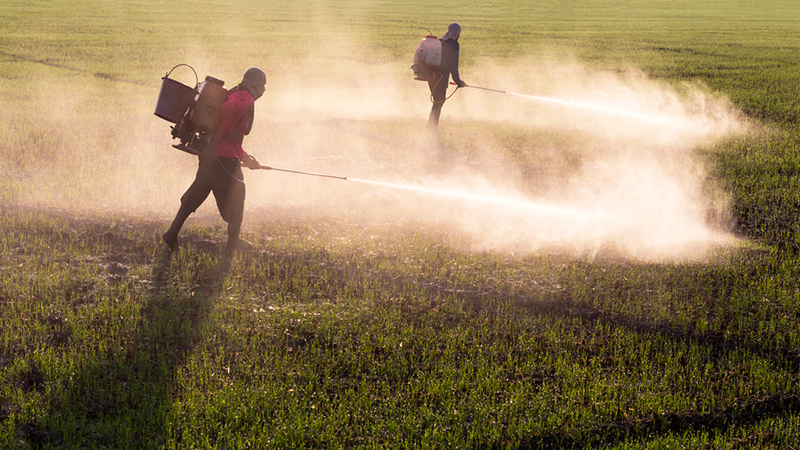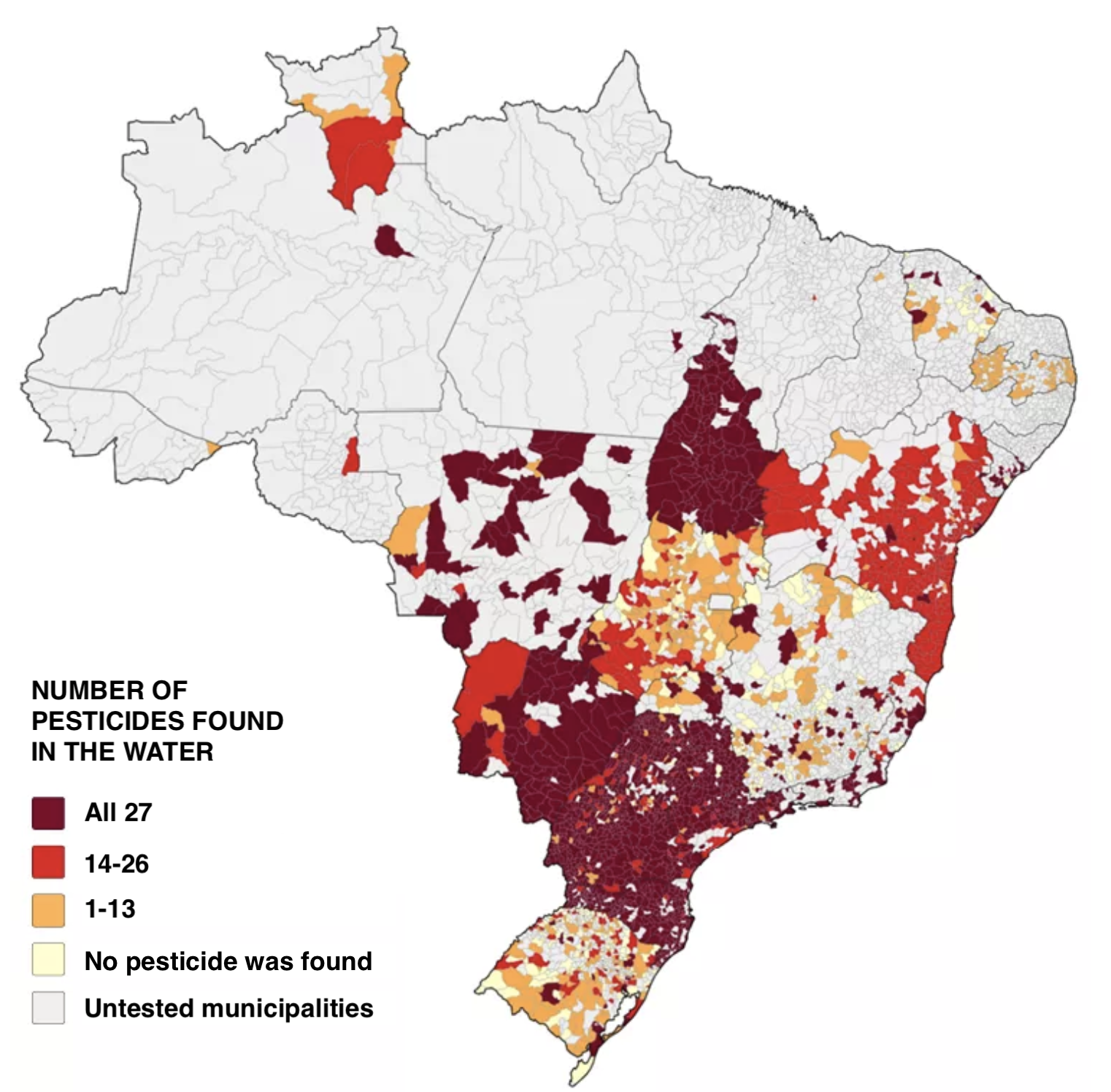A cocktail of a number of pesticides was found in the drinking water of 1 out of every 4 Brazilian cities between 2014 and 2017. In this period, supply companies in 1,396 municipalities detected the presence of all 27 pesticides which they are obligated to test for by law. Of these, 16 are classified by Brazil’s sanitary authority (Anvisa) as extremely or highly toxic, and 11 are associated with the development of chronic diseases such as cancer, fetal malformations, and hormonal and reproductive dysfunctions.
Among the cities with multiple contaminations are the state capitals São Paulo, Rio de Janeiro, Fortaleza, Manaus, Curitiba, Porto Alegre, Campo Grande, Cuiabá, Florianópolis, and Palmas.
The data is from the Ministry of Health and was obtained and analyzed in a joint investigation by Repórter Brasil, Agência Pública, and Swiss organization Public Eye. The information is part of a public database on drinking water quality, known as Sisagua, which gathers results from tests carried out by supply companies.
The numbers show that water contamination is increasing constantly and significantly. In 2014, 75 percent of tests detected the presence of pesticides. This level rose to 84 percent in 2015 and 88 percent in 2016, reaching 92 percent in 2017. At this pace, in the next few years it could become a struggle to find any water free of pesticides in Brazilian taps.
While the data is public information, the tests are not published in a comprehensive manner, leaving Brazilians in the dark about the risks they run drinking a cup of water. In a joint effort, Repórter Brasil, Agência Pública and Public Eye put together an interactive map with the pesticides found in each city. The map also shows which are above the safe limits according to Brazilian law and European regulation.
Click on the image below to find out the level of contamination in Brazilian cities.
The nationwide scenario of water contamination caused alarm among health professionals. “The situation is extremely worrying and certainly represents risks and impacts on the population’s health,” stated toxicologist and occupational physician Virginia Dapper. The concerns were shared by Aline Gurgel, a researcher in public health at the Oswaldo Cruz Foundation (Fiocruz) in Pernambuco: “alarming data, representing a serious risk to human health.”
Among the pesticides found in over 80 percent of the tests, five of them are classified as “likely carcinogens” by the Environmental Protection Agency (EPA) of the United States, and six are listed as endocrine disruptors by the European Union. Of the 27 pesticides found in Brazil’s water, 21 are banned in the EU due to the risks they offer to health and the environment.
The lack of monitoring is also a serious problem. Of Brazil’s 5,570 municipalities, 2,931 did not carry out tests on their water between 2014 and 2017.
Pesticides: a poisonous cocktail
The mixture between these chemicals was one of the aspects which created the most concern among the consulted specialists. The danger is that the combination of substances could multiply harmful effects or even create new dangers. These reactions have been demonstrated in tests, according to chemist Cassiana Montagner. “Even if one pesticide has no effect on human health, it could develop one when mixed with another substance,” explained Ms. Montagner, who researches water contamination in the Institute of Chemistry of the State University of Campinas (Unicamp), in São Paulo state. “The mixture is one of our main worries about pesticides in water.”
Inhabitants of São Paulo drank this cocktail more than anyone else in recent years. The state topped the list of the number of municipalities where all 27 pesticides were found in the water—over 500 cities, including Greater São Paulo and the state capital itself. The state of Paraná came in second, with the full cocktail present in 326 cities, followed by Santa Catarina and Tocantins.

The specialists speak at length about the “invisibility” of the cocktail effect. Public policy does not monitor the interaction between the substances as the studies justifying these policies does not highlight the risks of this phenomenon. “Chemical agents are evaluated in isolation, in laboratories, and they ignore the effects of the mixtures which happen in real life,” said Ms. Dapper.
She laments that the people already developing diseases as a result of this multiple contamination will probably never know of the cause of their illness, nor will their doctors.
Asked about the measures being taken to this end, the Ministry of Health replied via email reinforcing that “exposure to pesticides is a serious public health problem” and listing the harmful effects which could cause “premature puberty, altered breastfeeding, reduced female fertility and quality of semen, as well as allergies, cancer, and gastrointestinal, respiratory, endocrine and neurological disorders.”
The response, however, highlights that control and prevention actions may only be taken when test results surpass the limits established by law. And herein lies the problem: Brazil has no fixed limit to regulate the mixture of substances.
This is one of the demands of the groups requesting stricter pesticide regulation. “It is absurd that this problem remains invisible in the monitoring of water and that there are no actions to control it,” stated Leonardo Melgarejo, production engineer and member of a national campaign against pesticides. “If you find several pesticides, but each below their individual limit, then the water will be considered drinkable in Brazil. But this same water would be prohibited in France.”
Mr. Melgarejo is referring to the EU rule which seeks to restrict the mixture of substances: the maximum allowed is of 0.5 micrograms in each liter of water, adding up all the pesticides found. In Brazil, there are only individual limits. Therefore, adding up all the permitted limits for each pesticide being monitored, the mixture of substances in Brazilian water could reach up to 1,353 micrograms per liter without causing any alarm. This is equivalent to 2,706 times the European limit.

The risk of small quantities
Even when we look at the contamination of each pesticide in isolation, the situation is worrying. Of the 27 pesticides being monitored, 20 are listed as highly dangerous but the Pesticide Action Network, a group of hundreds of non-governmental organizations which work to monitor the effects of pesticides.
However, according to Brazilian law, the problem is small. Only 0.3 percent of all detected cases between 2014 and 2017 went over the safe limit established for each substance. Even considering the cases in which 10 banned pesticides are monitored, there are seldom situations when their presence in water causes any alarm.
This is the second warning made by the researchers: the individual limits are too permissive. “This legislation has gone for over ten years without review, it is such a setback from a scientific point of view,” said Ms. Montagner. “It’s like using an old black-and-white TV, when you can have access to something high definition.”
Here, Ms. Montagner is referring to the most recent studies on the risks of frequent consumption of small quantities, a form of contamination which does not cause immediate reactions. “Perhaps a given pesticide in the water doesn’t take 15 percent of the city to hospital in the same day, but its continuous consumption could cause even more serious effects, such as cancer, or thyroid, hormone, or neurological problems,” she warned. “We already have scientific evidence, but contaminated water keeps being considered drinkable because we don’t look at smaller quantities,” she said.
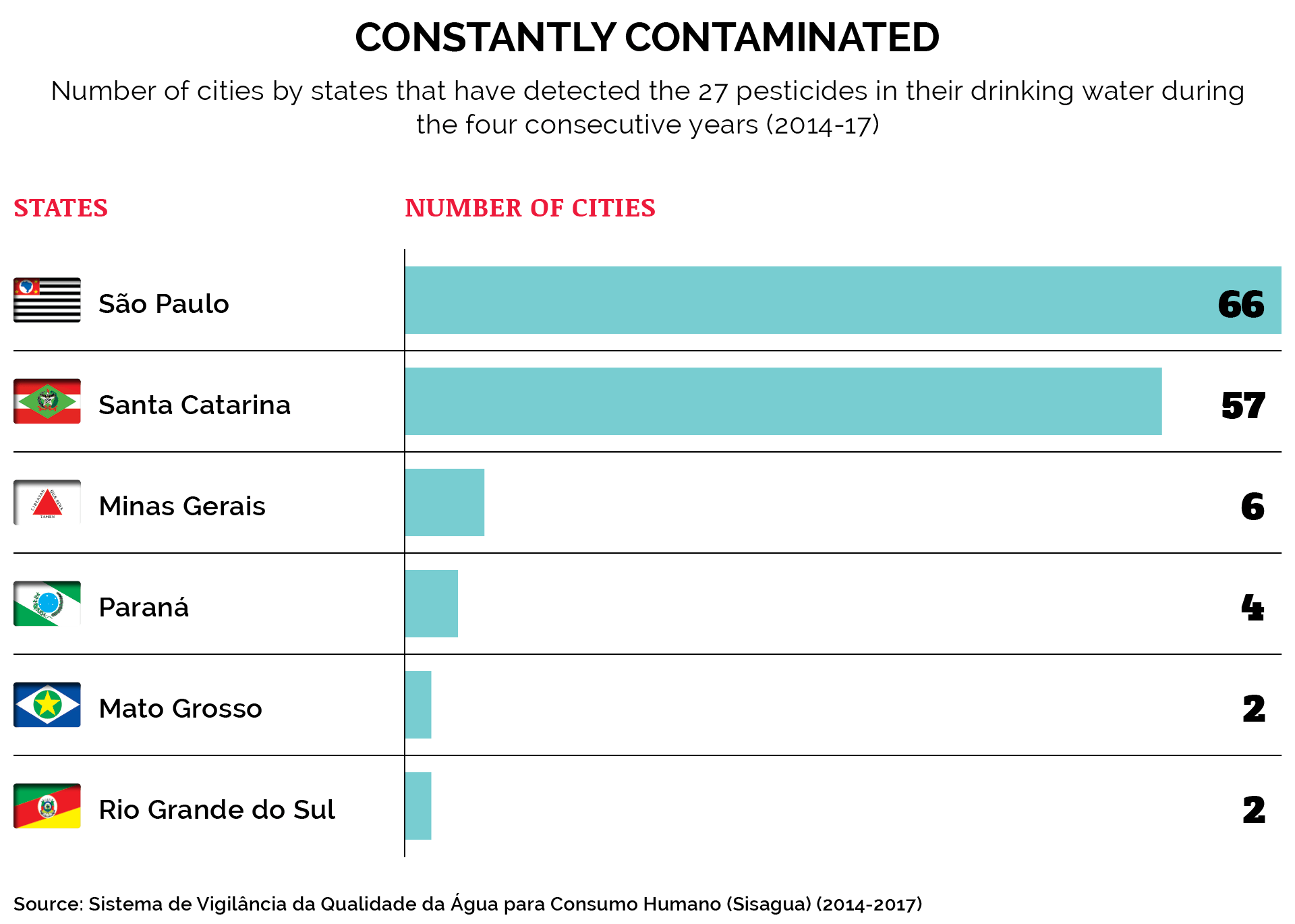
In response to this, a working group was put together by the Ministry of Health to review contamination limits. “We are doing a thorough job,” said Ellen Pritsch, a chemical engineer and the representative of the Brazilian Sanitary and Environmental Engineering Association in the group. According to her, international studies and regulations from other countries are being taken into account. Created in 2014, the expectation is that the work will be finished in September.
At least 144 cities detected the same pesticide continuously throughout the four years studied, according to the data. Once more, São Paulo leads the way in this type of intoxication. Specialists highlight the use of pesticides in the production of sugarcane as the probable origin of the widespread contamination in the state. “Sugarcane production has the most registered herbicides. As São Paulo is one of the biggest sugarcane producers, this would justify the elevated presence [of pesticides in the water],” stated Kassio Mendes, coordinator of the environmental quality committee of the Brazilian Association of Weed Science.
Diuron, one of the main herbicides used by the sector, was detected in all tests carried out in spring water of the regions where sugarcane is most present, according to 2017 data of the Environmental Company of the State of São Paulo (Cetesb). The substance is one of those listed as a likely carcinogen by the EPA in the United States.
Who is responsible?
Once contaminated, there are few available treatments to remove pesticides from water. “Some filters are able to remove some types of pesticides, but there are none which can take care of all of them,” said Mr. Melgarejo. “Mineral water comes from other sources, but they are supplied by water which runs on the surface, so potentially they will be contaminated too.”
Preventive work—in other words, stopping pesticides reaching water sources—must be primordial, said Rubia Kuno, manager of the human toxicology and environmental division of Cetesb. “Efforts should be on prevention, because the conventional treatment system is unable to remove pesticides from the water,” she stated.
There is a large debate on the complexity in facing the problem, but there is a lack of anyone taking responsibility.
The reporting team consulted the departments of the Environment, Agriculture, and Health, and the Basic Sanitation Company of the State of São Paulo (Sabesp) to find out which actions are being taken in the state with the highest levels of contamination. The replies came from Sabesp and the press office of the environment department with technical information about monitoring. Neither the departments of Sabesp clarified what is being done to control or prevent the problem.
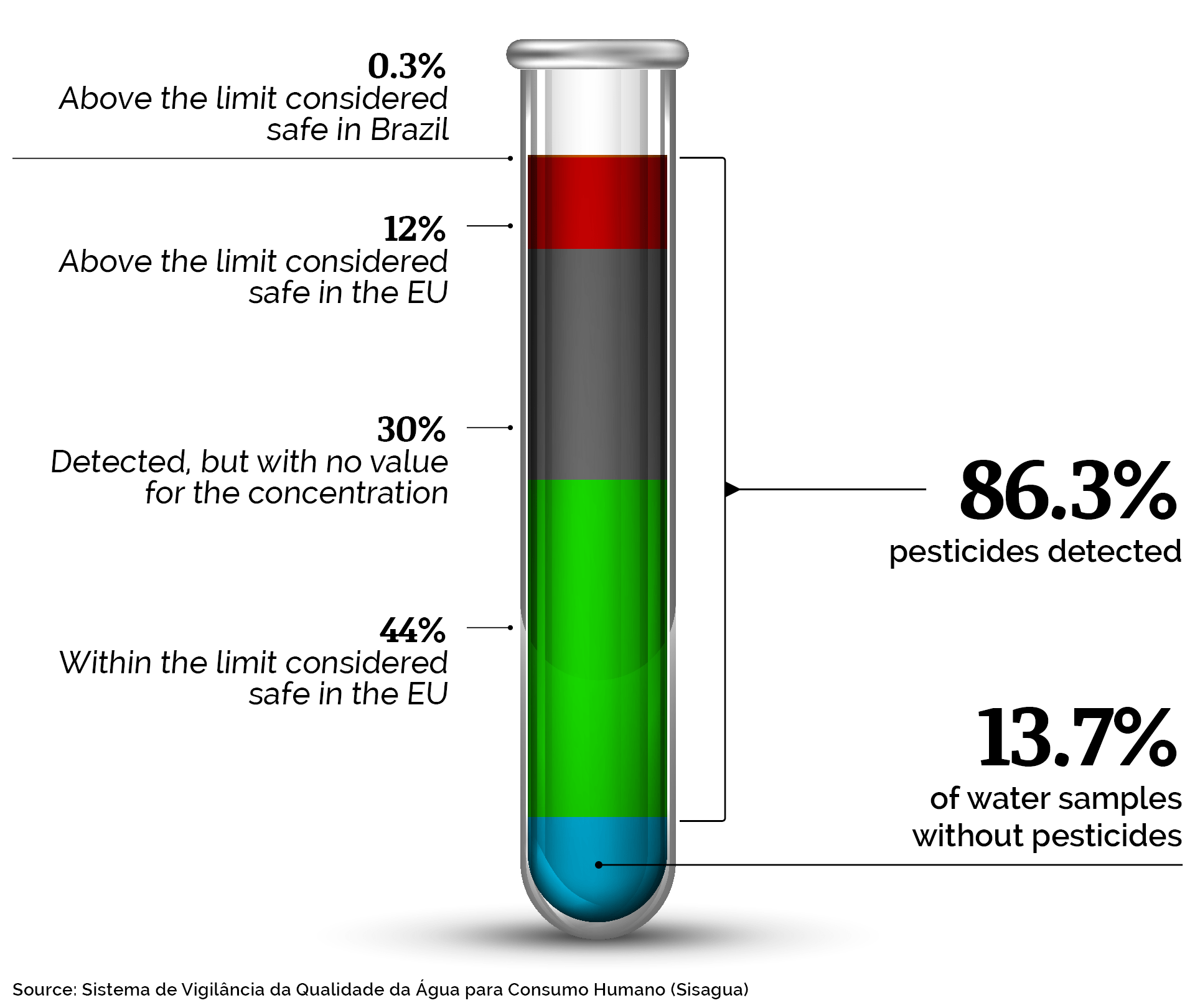
The Ministry of Health said the sanitary surveillance of municipalities and states should alert water supply service providers so that they may take measures to improve water treatment. “If the data show that the problem is systematic, solutions must be sought by articulation with other involved sectors, such as environmental agencies, service providers, and rural producers,” said the agency’s statement.
Asked about which actions are being taken, the National Union of the Plant Defense Product Industry (Sindiveg, representing pesticide producers) came out in support for the safety of pesticides. In a statement, the group said that evaluations carried out by Anvisa, the environmental protection agency (Ibama), and the Agriculture Ministry ensured that the substances are safe for workers, rural producers, and the environment “when they are used in accordance with the technical recommendations approved and printed on their labels.”
The union stated that the proper application of the products on fields is a challenge, and that the responsibility lies with the workers applying the pesticides. “The pesticide sector carries out initiatives to ensure the proper application of its products, as some structural problems in agriculture—such as the lack of the habit to read labels and illiteracy—bring an additional challenge to compliance with the recommendations for use.”
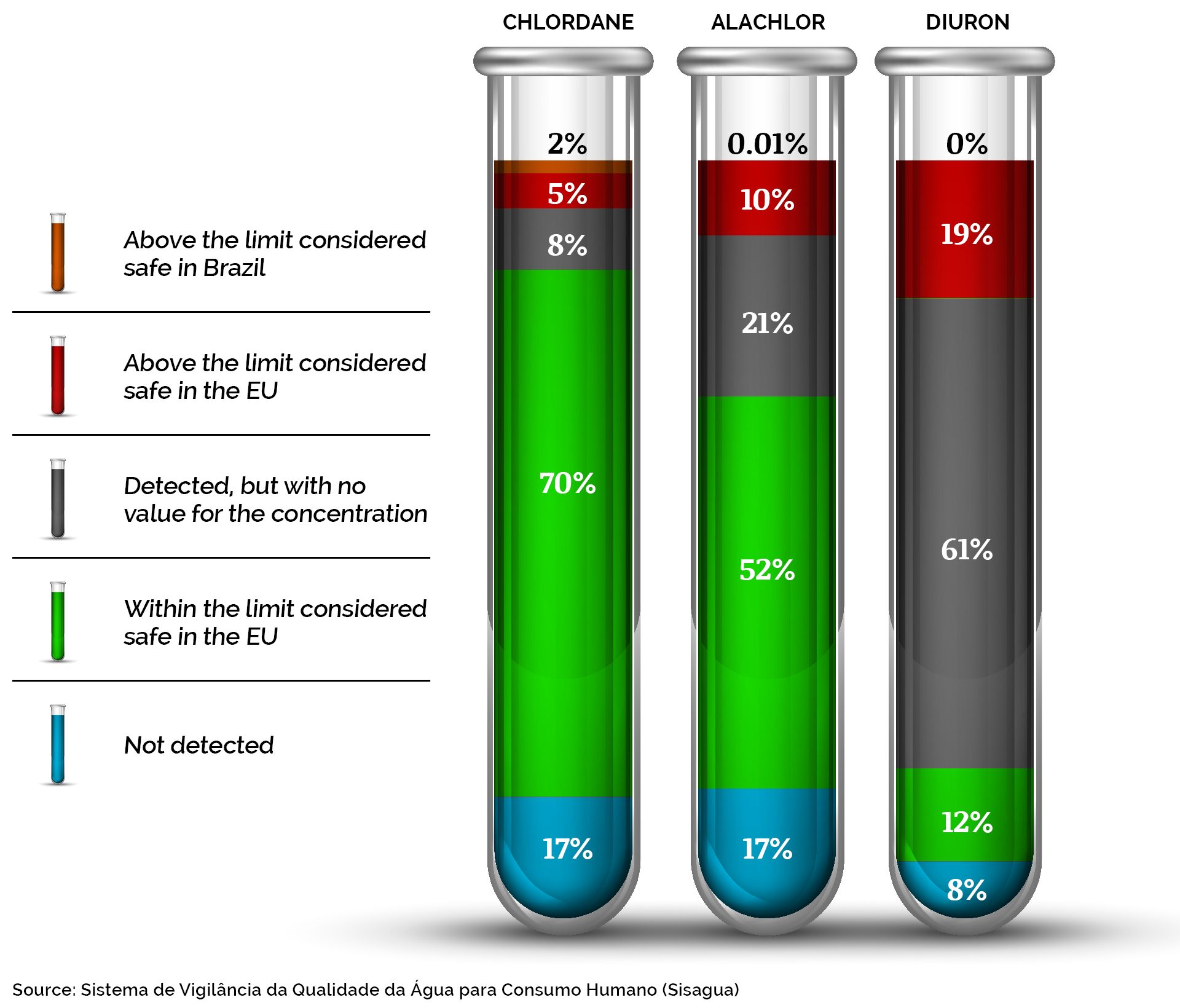
Contrary to what happens in other countries, in Brazil, companies which produce pesticides are not involved in water monitoring, which is funded by the public treasury and supply companies.
In Santa Catarina, one of the three most contaminated states, prosecutors have called on municipal governments, state departments, water companies, regulatory agencies, and unions of rural producers and workers to take responsibility. The initiative came from the results of a groundbreaking study which found pesticides in the water of 22 municipalities. “We have alerted all public and private agencies involved to look for solutions, we must apply corrective measures to reduce the risk for citizens,” said prosecutor Greicia Malheiros, responsible for the investigation. The initiative began in March this year and has yet to produce results.
Beyond mitigating water contamination, the study’s coordinator, chemical engineer Sonia Corina Hess, supports prohibiting the use of the highest-risk pesticides. Of the substances found in its study in Santa Catarina, seven are banned in the EU due to posing a risk to human health. “We must ban what has been banned abroad, we must ban what is dangerous. If it causes harm to them, why is it allowed in Brazil?” she asked.

Dangerous in Europe, permitted in Brazil
Brazil’s water control is also far from EU parameters. Aiming at eliminating contamination, the continent established the maximum concentration in water as 0.1 micrograms per liter—the minimum detectable amount when the regulation was created.
To discover how water in Brazil would be evaluated by European standards, Public Eye classified the data supplied by the Ministry of Health following EU criteria. Some of the most dangerous pesticides went over European limits in over 20 percent of tests. Among them were glyphosate and mancozeb, both associated to chronic diseases, and aldicarb, banned in Brazil and defined by Anvisa as “the most toxic pesticide recorded in the country, among all active ingredients used in agriculture.”
Glyphosate is the most revealing case about the peculiarities of Brazil in pesticide regulation. Classified as a “likely carcinogen” by the International Agency for Research on Cancer, an agency of the World Health Organization, the pesticide is being debated all over the world. Thousands of cancer patients are winning lawsuits against manufacturers in the United States, while protests and petitions have demanded its banning in Europe. There is no consensus about its classification among regulatory agencies. In Brazil, which officially put the substance up for revision in 2008, the Ministry of Agriculture cleared new licenses for the sale of glyphosate at the start of this year. The pesticide is now being sold in new forms, quantities, and by a larger number of manufacturers.
In tests on water around the country, the controversial substance was the one which most surpassed the safety cutoff established by the EU: 23 percent of cases were above the limit. By Brazilian law, glyphosate was among the pesticides which caused least alarm, with only 0.02 percent of tests going over Brazilian limits.
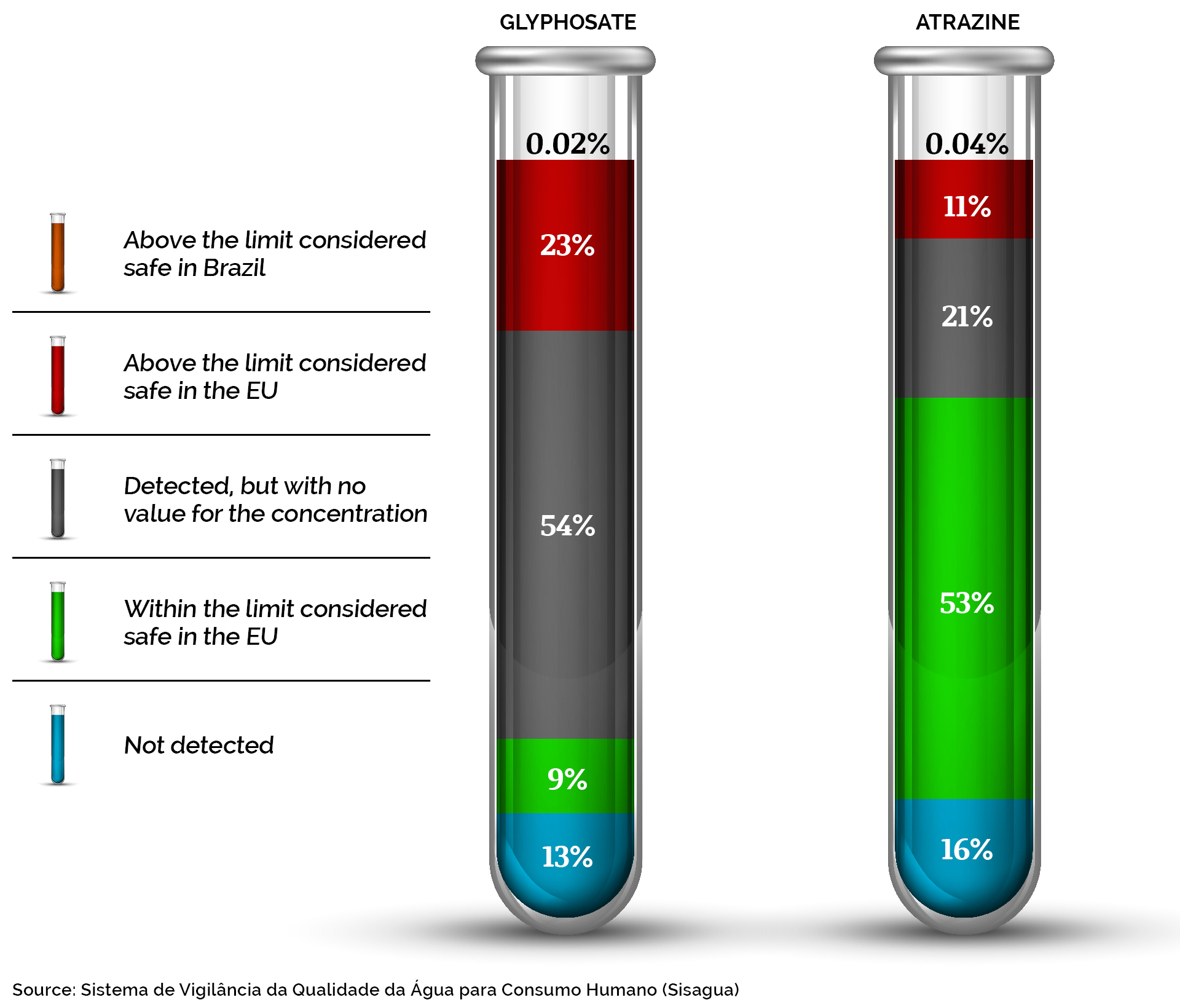
“This is a public health scandal. We’ve put the limit high up in the stratosphere, and we say that we have safe water,” complained researcher Larissa Bombardi, a geography professor at the University of São Paulo and author of an atlas comparing Brazilian and European pesticide law. Her study shows that Brazil’s limits are up to 5,000 times higher than those in the EU. The most serious case is glyphosate: while in Europe only 0.1 micrograms per liter are permitted, in Brazil, the law allows for up to 500 micrograms per liter.
As glyphosate is the best-selling pesticide in Brazil and has the most generous limit for presence in water, Ms. Bombardi is suspicious of the criteria being used: “in the case of glyphosate, it is really difficult to find scientific justification, it seems to be more of a political and economic decision.” The pesticide was the most consumed in 2017 in Brazil, with 173,000 tons sold, according to Ibama. The volume corresponded to 22 percent of sales estimates for the whole world in that year, making Brazil an important market for manufacturers, among them giants Syngenta and Monsanto—acquired by Bayer last year.
Generous limits for pesticides
The broad difference between the limits established by the EU and Brazil is one of the main arguments used by critics of the use of the substance in Brazil. “This difference could only happen for two reasons. Either our society is stronger and we are more resistant to pesticides. Or we are stupider, because we are being naïve about the risks we are running,” says Mr. Melgarejo, of the Campaign Against Pesticides.
Ellen Pritsch, of the working group to review limits of pesticides in water, disagrees. In her opinion, the current limits are safe and were established with scientific justification. “Brazilian criteria are ten times less than the effect which would create the problem. So, even if a percentage above this level is found, it would still be below [the level of risk],” she stated.
Before approving pesticide licenses, manufacturing companies submit studies with tests on animals in laboratories. Sindiveg argues that these studies suffice to evaluate the risk of substances. “These are bioconcentration studies on fish and micro-organisms, algae and soil organisms, bees, microcrustaceans, fish and birds,” read a statement sent by Sindiveg in response to questions.
The main demand of groups campaigning for the control of pesticides is for more restrictions and the banning of some pesticides already approved in the country, such as atrazine, acephate, and paraquat, which are top sellers in Brazil but banned in the EU.
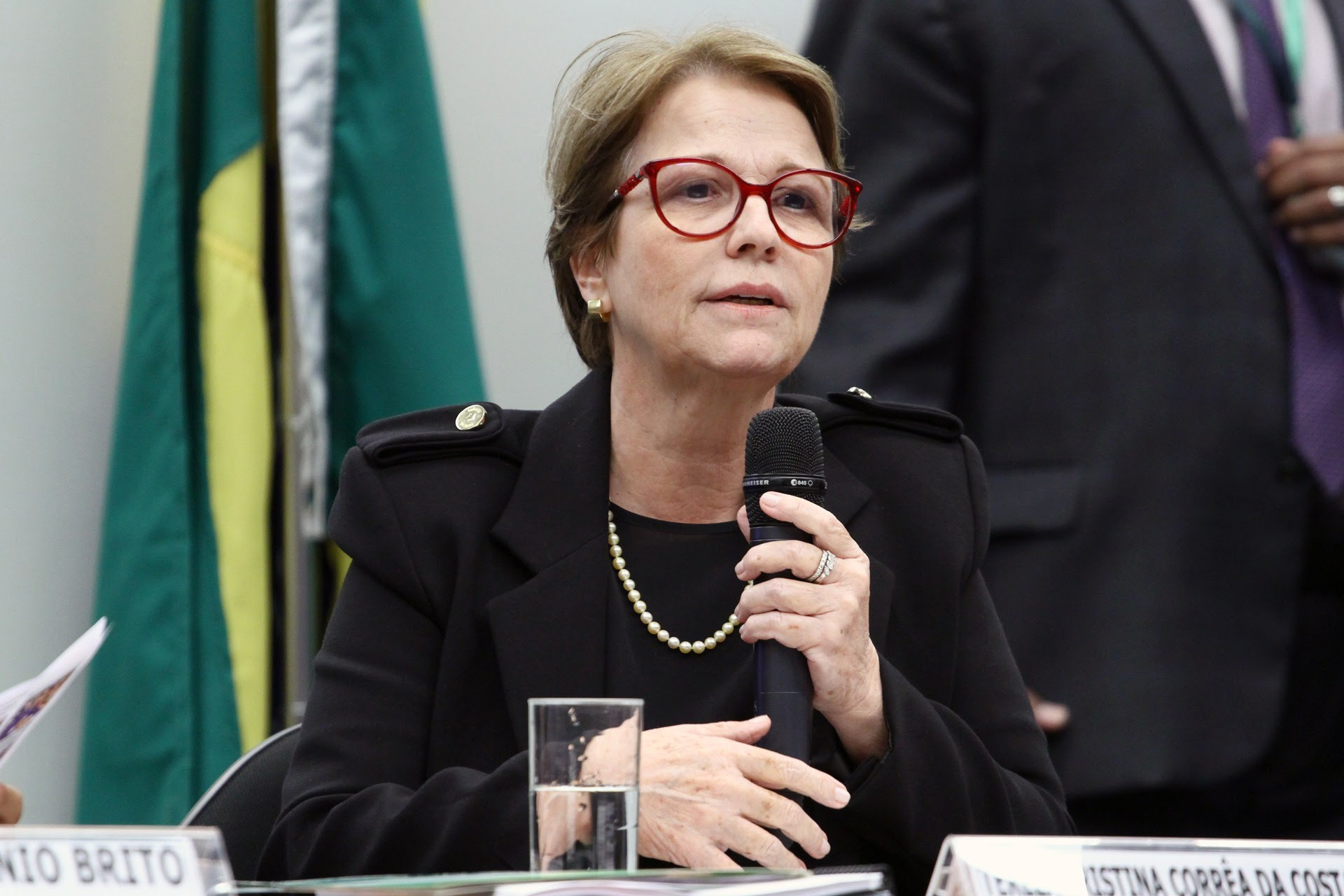
However, the governor is pulling in the opposite direction. Agriculture Minister Tereza Cristina was the president of the special committee in the House of Representatives which approved, last June, a bill to speed up the approval of new pesticides in the country. Nicknamed the “poison bill,” it caused some controversy, being criticized by a letter signed by over 20 groups from the scientific community.
With no expectation of managing a majority in Congress to approve the bill, the strategy appears to have changes. Since the beginning of the year, the Agriculture Ministry published new licenses for 152 pesticides, a record speed of 1.5 approvals a day. Invited to clarify these licenses in a House hearing last month, the minister said there was no “general clearance” and that long approval procedures only hinder Brazilian agribusiness.
She dubbed studies highlighting the risks of these substances as “disinformation” and, using the same argument as the pesticide producers union, declared that intoxication occurs in accordance with the way workers apply the substances. One day after the hearing, the government approved the sale of another 31 pesticides in Brazil.
Translated by The Brazilian Report.
